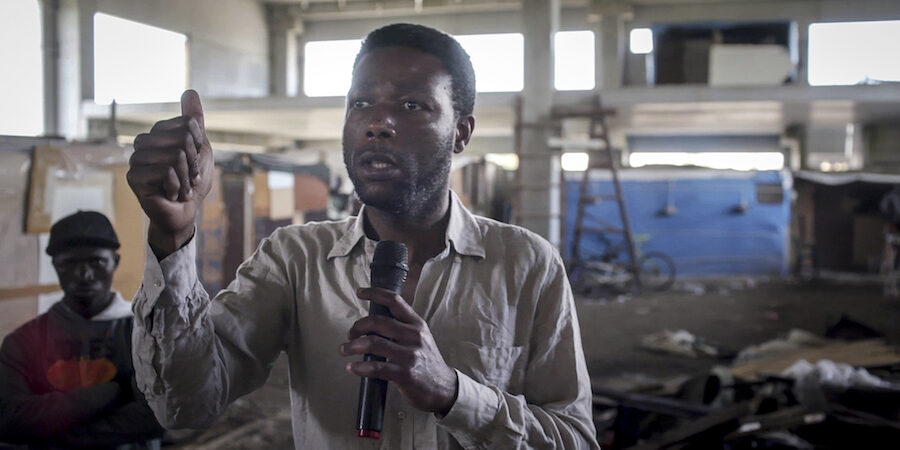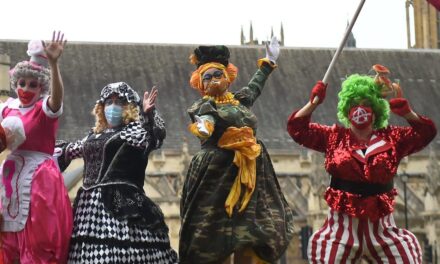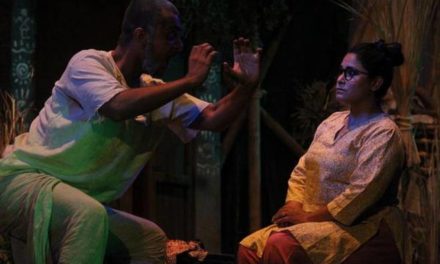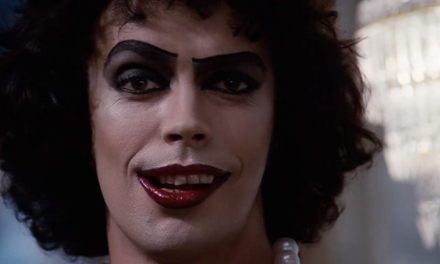Milo Rau was to receive an honorary doctorate from the UGent in March. Corona decided differently, but Etcetera decided to go ahead and publish the essay Rau wrote for this occasion. The essay has been translated by Lily Maeve Climenhaga.
“Proceeding from times of global exploitation, we can only look at our intercultural collaboration as a continuation of this exploitation. Solidarity is considered as interference by Western mainstream. Maintaining contradictions – and, unfortunately, often also breaking them – is considered as an irresponsibility. Nevertheless, how can we dare to create an extreme, revolutionary “global art”?
Last year, we filmed The New Gospel in Southern Italy with actors from the Jesus films of Pier Paolo Pasolini and Mel Gibson, with including a cast of Italian farmers and African plantation workers and activists.
In the region surrounding Matera, the European Capital of Culture 2019, and the filming location of Il Vangelo Secondo Matteo and The Passion of the Christ, roughly 500 000 African refugees are stuck there. They live in shacks or improvised tents and because of the Dublin Convention, they can neither move forwards nor back. They are forced to work on tomato and orange plantations for the lowest wages possible. With these cheap products, the manufacturers flood the refugees’ home countries, thus destroying the local agricultural industry: a perfect neoliberal economic cycle, in its relentless cynicism.
What could be more obvious, than to bring the social revolutionary myth of Jesus and his followers into the 21st century?
Where Politics Fail
When we accompanied our Jesus actor of The New Gospel, former plantation worker and present-day activist Yvan Sagnet to the camp to call refugees to action in a demonstration against their illegalization, it was an open – and, therefore quite dangerous – revolt against the dominant situation. The agricultural industry in southern Italy is controlled by the Italian and Nigerian mafia, who in turn collaborate with major food corporations. The various national refugee groups are played off against each other by the state and the entrepreneurs. Sagnet’s uprising consisted precisely of uniting the effected groups in their common struggle for rights and dignity: African and Italian farmworkers, sex workers, traditional trade unionists, small independent farmers, and internationally active NGOs.
While we were filming – the Jesus film The New Gospel is coming to the cinema in the autumn of this year – Rivolta Della Dignità led to the founding of the “Houses of Dignity”, among other things. Which was largely under the organization of our dramaturgs Eva-Maria Bertschy and Yvan Sagnet – and has provided around 50 of the formerly homeless and illegal performers in The New Gospel with permanent residence and papers. By the end of the year, this number should increase to 1350. Similarly, a project from a few years ago, The Congo Tribunal, which created a transnational court to prosecute the economic crimes of Western corporations in the Eastern Congo, is also something other than an art project, something different than simply a movie: it is an act of civil self-empowerment. It creates living and fields of action that were not foreseen in the global economic system.
“Where politics fails, only art can help”, Die Zeit wrote about The Congo Tribunal. For there is, paradoxically, only a global economy, a global climate, global flow of information, and refugees; a global civil society or even global legislation does not exist. They have to be created by our generation, as a utopian, unfinished project. In this type of project – as is currently the case with ‘Antigone in the Amazon’, for which we are working together with indigenous activists and the landless movement in the Brazilian Amazon – the question arises: What side effects does this self-realization bring to those involved? Doesn’t so-called “global realism” entail a danger that the already exploited, the lawless, and those robbed of self-esteem simply return to their role as oppressed in the artistic superstructure of global capitalism?
The Act of Solidarity of Art Production
I think this problem indeed exists. I think that global solidarity or art should more or less be measured by how they deal with these contradictions: how they thematize this paradox, but – which is even more important – don’t get stuck in the thematization and the narcissistic overreactions to them (white guilt, etc.), but instead try to deal with them despite all the contradictions. Yes, I even believe that the term “art” as we Europeans have defined it since Romanticism, no longer works here – which is why, over ten years ago, I suggested the term “Unst”: an “art” that not only consists of the end product but above all, consists of an act of solidarity of the art production itself. Or, in other words: In reality, the designation of projects like The New Gospel as art in the bourgeois sense of the word – i.e., as an invitation to a “work” or an “exhibition”, a “publication” or a “premiere” – is simply a trick to create space for civil society to emancipate itself.
In addition to the film’s image politics (a black Jesus, female apostles, etc.), it was equally important for us that The New Gospel was not only a film, an exhibition, a live passion spectacle, and a political campaign, but that is also supported (and remains to support) the first plantation in Italy managed by migrants themselves. That houses will be built for the people who took part in this project, who currently still live in barracks and that they receive their papers. That The New Gospel – despite all its flaws – is a revolutionary example of post-capitalist land grabbing, a piece of realpolitik that attempts to reconcile the concepts of migration and fatherland (that are currently played off against each other under the guise of identity politics).
“I believe that global art opens windows of opportunity, it brings together what is far away, in this case, a white European myth from the Middle East and a black savior, religion and revolution, “soft” images and “hard” realpolitik”
And whatever succeeds and whatever fails: I believe that global art opens up a window of possibilities, it brings together what is far away, what is seemingly not connected: in this case a white European myth from the Middle East and a black savior, religion, and revolution, “soft” images, and “hard” realpolitik. “Rather good social work than bad art”, Matthias Lilienthal once said; in global realism, aesthetic and social imagination belong together, without hierarchy. Mnouchkine, Brecht, Schlingensief, or Beuys: were they social revolutionaries, politicians, or artists? Or Simone de Beauvoir? Or Che Guevara? Or Pussy Riot? Are they privatist or universalist? Have they not united the two – and thereby, as Srecko Horvat in The Radicality of Love wrote, became entangled in final unsolvable contradictions?
An effect of globalization is that cause and effect are separated from each other, in warlike, economical, ecological, or simply psychological use of power. We consume images and resources that are produced in parts of the world we don’t even know. The sociologist Stephan Lessenich describes de European industrial countries as “outsourcing societies”: the social and ecological consequences of our lifestyle are exported to Africa, the Middle East, or the camps on Europe’s peripheries – as in earlier centuries they were to the dark suburbs. Global realism now attempts to reverse these outsourcings in the context of projects.
I believe that bourgeois art, which – however avant-garde it may be – always remains identitarian art, which no longer makes sense because the outsider position in global capitalism no longer exists. It is only when one understands seemingly foreign, distant conflicts as one’s conflicts, that one enters the level of global flows of capital and consciousness.
New Cultural Infrastructures
Jesus returns to Europe, but he comes from Cameroon, and his apostles are refugees, farmers and sex workers, anarchists, philosophers – but also police officers, everyday Italian citizens, actors. The problem with such inclusive and globally conceived aesthetics is, of course, that the problems that are shipped off to an imperial outside world, suddenly become too internalized and too artistic. Where the state is absent, one is sometimes forced to cooperate with the local mafia-driven power structures or with corrupt elites, at least for a while. Or one intervenes in intercultural debates, where the true potential for violence only emerges during the project itself (Orestes in Mosul). In short: if you work outside the safe boundaries of Western discourse, you expose yourself to the truth of the circumstances.
Within the project, the “in the colonies localized nakedness” of Capitalism returns, like Marx called it, that the Western welfare state and therefore our democracy is based on. The global artist becomes the ‘capitalist of suffering’ as I wrote five years ago, while on tour in Eastern Congo for the film version of the first Congo Tribunal: the system and the sensitivity controlled by this system, are stronger than the intent and even the reality. Whatever one does, it will be read into outdated systems of representation and perception. For global art, fundamentally and methodically, goes “too far”.
This applies – at least in our experience – especially to status differences and matters of identity politics: externalized contradictions become shared contradictions, theoretical debates become real problems, “cold” facts become “hot” issues. Conflicts arise, but also – if one understands conflict dialectically – mutual learning and, above all else, long-term exchange processes. Working globally means creating networks of theoretical debates and practical solidarity, that are not foreseen in the current system. “This is the only art that helps us”, Yvan Sagnet said in a panel a few weeks ago, about The New Gospel and the Rivolta Della dignità. Because by working in regions without a cultural infrastructure – as it is stated in rule nine of the Ghent Manifesto – new cultural infrastructures inevitably emerge: whereas in the Eastern Congo – there are simply no cameramen or theatre spaces, whereas in Iraq – there are no opportunities for female or queer actors to perform, some have to be created together.
“Working globally means creating networks of theoretical debates and practical solidarity, that are not foreseen in the current system.”
And precisely because there are no existing structures that you can fall back on, no canon and no codex – or that you even have to break them to get the necessary room to move – such projects are always extremely time-consuming and labor-intensive. The work on Congo Tribunal began at the end of the 2000s. The first Congo Tribunal took place in 2015 and in September 2020, another five years later, the second one takes place, filmed by a local production company. Orestes in Mosul is, in turn, the documentation of an Oresteia workshop in Mosul in March 2019, the initial highlight of an exchange that we had started in the summer of 2016 in northern Iraq with Empire. As it says in the Ghent Manifesto: “theatre is not a product, but a production process”. Only two months after the Iraqi premiere of Orestes in Mosul, were we able to finally bring two of the artists from Mosul to Europe and organize a series of events. A collaboration arose between a school in Bochum and the art academy in Mosul with other exchange projects on their way. And soon we’ll be returning to Mosul to shoot a film with our Iraqi colleagues.
A Solidarity-Based Critique
Of course, all this remains invisible to a critique that is speculative about long-term processes. Social or structural aspects are usually even consciously ignored by classical academic or press critics, because it should be “only about the piece itself” and “only about the artist” – which, of course, falls back on the artists as an accusation. Why, for example, did the critic (not just the Italian and not just the right-wing) of Yvan Sagnet’s and other activists’ decision to play the role of Jesus or the apostles fall back on words like “pretension”, “megalomania”, “positive racism” and “tokenism”? I suspect that this is a – largely unconscious – legacy of a bourgeois concept of art that is accustomed to cultural homogenous production structures, purified of social struggles. Whereas the actors have more or less identical backgrounds of experience, it is logically “about art” and not about those involved, about the product and not about the production process. It then seems as if bitter intercultural expositions such as in Mosul, in Congo, but also in “European” projects such as Lam Gods or the Europa Trilogie are not conflicts deliberately created by all those involved, but simply scandals that a more professional team would not even have allowed. No wonder, to paraphrase Brecht, that one usually learns as much from such an educated critique of global art production as from a photograph of a factory facade about the work contexts in that factory: this criticism only says something about the aesthetic preferences of the artistic team and those of the critic, about the Western moral “common sense” and its vocabulary and the similarities between the two.
“I dream of a critique that takes time to get to delve into a case without identifying with it.”
I remember, for example, how Schlingensief’s Opera Village was discarded as self-realization party of a Western artist, the same with Simone de Beauvoir, to an even higher degree, when she showed solidarity with non-European freedom movements. It’s understandable: proceeding from times of global exploitation, we can only imagine intercultural collaboration as a continuation of this exploitation. Solidarity is seen as interference by the Western mainstream, as the endurance of contradictions – and, unfortunately, often also their breakage – as irresponsibility. We artists take part in this game of externalization, when, out of fear of ending up in the barrage of overheated identity discourse, we present morally and politically purified façades and no longer concern ourselves with global art production or even with the contradictions of this art production as such. That’s why the second rule of the Ghent Manifesto stipulates that all rehearsals are open and that all employees are allowed to speak with the media (or whomever) whenever. To make contradictions visible and negotiable, for example, we produced a film about the rehearsals of Lam Gods (my opening production in Ghent), as well as for Orestes in Mosul. These films show, as will also be the case with The New Gospel, an imperfect, tentative, often hysterical search. Because, in fact, every realism – and global realism in particular – is a minefield and deeply questionable. Who represents what? Who determines what will be performed?
Working in East Congo, in the Italian refugee camps or Iraq causes countless sleepless nights, both for local and European partners. The social sustainability, which even after years of cooperation is still perceived as insufficient, is terrible and leaves many in my team exhausted and discouraged. It is incredibly difficult to work with people from different backgrounds and with different political views, both in Ghent and in Goma. You push and you are pushed, you convince and you become convinced, you agree until the debate starts again. In this way, improbable solidarities are created, which sometimes also breaks down, due to constant internal and external pressure.
However, it is only these points of friction – such as the simultaneously beautiful, but for me as an atheist also questionable fact that the Catholic Church now supports the Houses of Dignity or currently the cooperation between actors, activists of the landless movement and indigenous resistance movements in Brazil – that make realistic art come true in the dialectic sense: a complex, painful image of a globalized world. So I dream of an adventurous, creative, solidarity-based critique that can withstand the contradictions. A critique that takes the time to delve into a case, without identifying with it.
Which understands the “work of art” as an alibi, to reflect on the contexts it is dealing with, and thus perhaps finds better, more correct, more precise ways of describing (and maybe even transforming) reality. Much like Samuel Beckett’s catchphrase: “Try again. Fail again. Fail better.”
This article was originally posted at e-tcetera.be on April 15, 2020, and has been reposted with permission. To read the original article, click here.
This post was written by the author in their personal capacity.The opinions expressed in this article are the author’s own and do not reflect the view of The Theatre Times, their staff or collaborators.
This post was written by Milo Rau.
The views expressed here belong to the author and do not necessarily reflect our views and opinions.

















